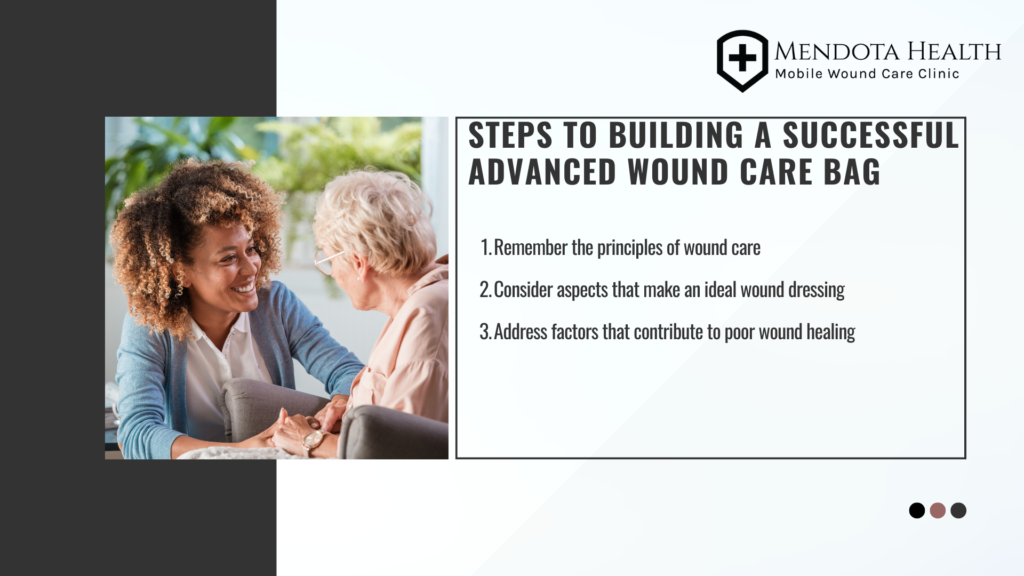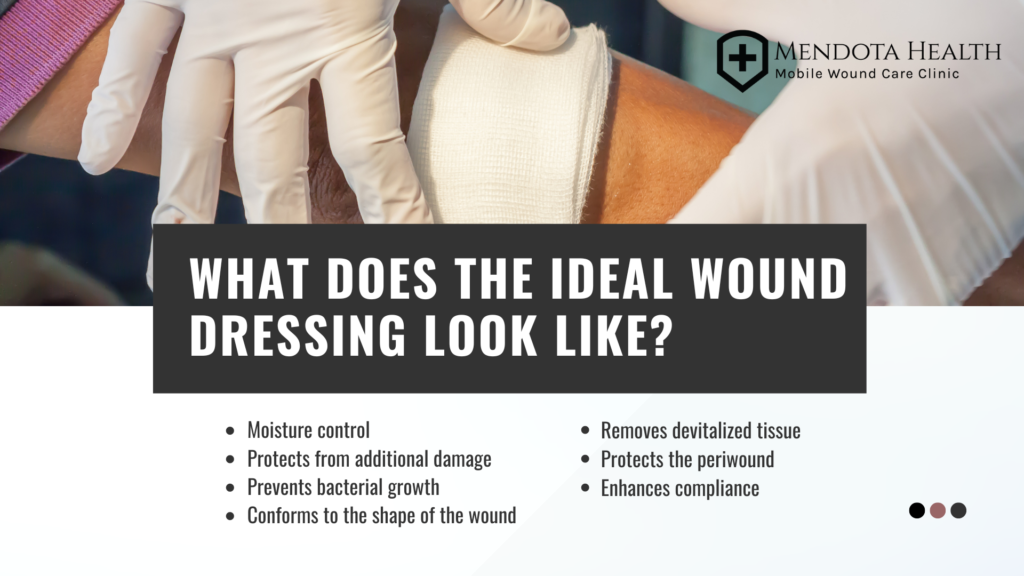
10 Sep What’s In Your Bag?
Whether you are new to mobile wound care or a seasoned provider, one question that often arises is, how do I pack my bag? Advanced wound care requires an evidence-based approach. We must keep in mind the purpose and goal of any treatment plan developed is to enhance a patient’s quality of life while working towards wound healing. Selecting what products to use for wound care can be a daunting task given the vast number of options. A few key steps can help guide the process:
- Remember the principles of wound care
- Identify and treat the underlying etiology and contributing factors
- Consider what dressing will effectively treat the wound
The principles of wound care encompass knowing what type of wound you have; this will guide your treatment and supplies needed. You must identify the underlying etiology while managing any contributing factors such as pressure, edema, infection, and debriding devitalized tissue. Use products that provide the correct balance of moisture while filling in any dead space. Following each step in the principles for chronic wound management will lead to promotion of tissue growth.
Identifying Contributing Factors and underlying etiology
The first step in chronic wound management is identifying contributing factors and the underlying etiology. Being able to identify these components will arm the provider with knowledge on how to treat the wound while reducing the risk of recurrence. One of the most under identified contributing factors to non-healing wounds and unnecessary amputations is vascular disease. Being able to have tools in the mobile wound clinic arena to help screen and/or assess the vascular status for any patient with lower extremity wounds is a key component of what must be in your bag. Assessing the vascular status of patients starts with the physical assessment. You must take shoes and socks off both feet. Feel for temperature changes while assessing the color, hair growth, and pulses. If unable to feel a pulse you must further investigate. Having a handheld doppler further in your bag to assess pedal pulses is necessary.
The last component of assessing for vascular insufficiency is to obtain an ankle brachial index (ABI) and/or toe brachial index (TBI). An ABI is a non-invasive test to help screen and identify peripheral artery disease (PAD). ABIs can also be used to help guide selection of compression therapy (no compression for ABI less than 0.5). There are a few exclusion criteria to getting an ABI including patients who are unable to lay supine or have an acute DVT. One must remember who the patient is when getting an ABI and take that into consideration when interpreting the results. Patients who have diabetes and/or renal disease often have non-compressible arteries (ABI > 1.3) which leads to inaccurate readings. If your assessment of a patient does not align with the ABI results, get further testing. In fact, the American Heart Association recommends that patients who have diabetes or end stage renal disease must have an alternative noninvasive test to diagnose PAD including a TBI or doppler waveforms. 8% of ABIs are abnormal and this is likely closer to 20% in patients with wounds. The American Heart Association recommends that any patient with a chronic non-healing wound must also have a TBI even if the ABI falls within normal range due to the high risk of having falsely elevated readings. Lastly, remember if a patient has a procedure to restore circulation in their lower extremities, this is not a one and done. Patency at one year is 50% (pending type of treatment) and around 20-40% of individuals with non-healing wounds require additional procedures to restore circulation within the first year. A patient with a non-healing wound must get vascular testing at least every 90 days if not more often.
treat contributing factors
The next step in wound care is to treat any contributing factors such as pressure relief and compression therapy. Ensure your patient has the necessary resources including multilayer compression, offloading boots, and air mattresses. You must also provide education to your patients about how these products are correctly used and why they are important to the treatment of wounds as well as reducing the risk of recurrence.
Moving on to infection control and debridement. Chronic wounds by default are contaminated with bacteria often leading to infection. If there are no clinical signs of infection: expert opinion and clinical guidelines recommend against routine use of antimicrobial dressings or systemic antibiotics. Only treat those with clinical signs of infection. A facilitator for the development of chronic infections that are often resistant to antibiotics and antimicrobials is biofilm. Remember that you cannot always visualize biofilm; however, biofilm is present in 80% of chronic wounds. Debridement promotes healing by reducing bioburden and disrupting the biofilm. Debridement prepares the wound bed by controlling inflammation and reducing risk of infection. Keep the right tools in your bag for debridement based on your patient’s presentation (autolytic, enzymatic, or mechanical).

ideal wound dressings
Now that we have discussed what leads up to selection of wound dressings, we can further discuss what the ideal wound dressing looks like. An ideal dressing is one that has the following characteristics: maintains a moist environment, protects the wound from further damage, prevents bacterial growth, conforms to the shape of the wound while also filling in dead space, removes devitalized tissue, and protects the periwound. The ideal dressing would also enhance compliance by causing little to no pain and requires minimal dressing changes. Remember if the wound is dry make it wet and if it is wet make it dry! You will have to prioritize treatment goals when selecting which wound therapy to use at each visit based on updated wound assessments.
Having the understanding of what type of wound a patient has and how to treat that wound will provide you with the necessary information to select the appropriate wound dressings. The goal is to promote moisture balance while taking into account methods to reduce pain and prevent infections. Advanced wound care dressings are designed to enhance biocompatibility, durability, and moisture retention. Dressing choice needs to be determined based on the same day assessment of the wound as well as what the dressing will provide to the wound to promote healing. Factors to keep in mind when selecting products include type of wound, location, signs of infection, level of exudate, wound bed environment (dry vs wet), periwound characteristics, and factors leading to compliance such as frequency of dressing changes. Examples of advanced wound dressings include hydrogels, hydrocolloid, alginates, antimicrobials, collagen, and foams.

skin substitutes
The final step in advanced wound care includes the use of skin substitutes. But how do you get to this point? You have to ensure the checklist for skin substitute is complete:
- No infection
- No bone exposure, tunneling, or undermining
- Documented vascular studies (if warranted), A1C (if warranted), tobacco cessation counseling (if warranted), and nutritional assessment
- Wound failed to improve more than 40% in 4 weeks with conservative treatment
Once each of the above items is met you are ready to use skin substitute. The goal is to continue using skin substitute for 10-14 weeks or until the wound has healed. However, frequent reassessment is needed to ensure there is no regression in healing around 4 and 8 weeks. If this occurs taking a break from skin substitute and trying an alternative treatment is warranted.
There are over 75 skin substitutes currently available with many more in the works. The biggest factor that plays a part in selection of skin substitute is insurance authorization followed by wound type. Evidence supports the use of the allogeneic graft in venous leg ulcers, diabetic foot ulcers, and pressure ulcers making it the most commonly used type in the mobile wound clinic.
conclusion
In conclusion, there is no single product that is suitable for all wound types. You must select a product with the most ideal characteristics that meet the needs of the wound. Wound care requires an ongoing assessment of the wound while having knowledge regarding the purpose of each dressing choice. Not only do you need to pack your bag with basic tools such as scissors, gloves, and skin prep. You also need to include advanced wound care dressings, debridement tools, skin substitutes, and vascular assessment tools as discussed throughout this article. Lastly, there are non-tangible items for your wound care bag. Knowledge is a key attribute and necessary item for your toolkit. Knowing your resources, understanding the underlying disease process, identifying early signs of regression, and knowing when to escalate or de-escalate a treatment plan is crucial. You are the most valuable tool and must continue to adapt while applying evidence-based practice.

Dr. Shepler presented What’s In Your Bag? at the innagural IPAWS International Post-Acute Woundcare Society Summit in New Orleans.
About Dr. Shepler
I have been in healthcare for nearly 15 years. Started as a CNA and made my way up to DNP. A majority of my experience is in the cardiovascular field ranging from CVICU, cardiac cath lab, and outpatient CV clinic. Throughout this journey I have had the opportunity to help lead this community while enhancing the future and positively impacting our patients outcome. More recently as a Nurse Practitioner I have developed a passion for CLI and amputation prevention. My goal for the future is providing education and outreach to patients and clinicians about CLI and what options are available, amputation is not always the answer.

